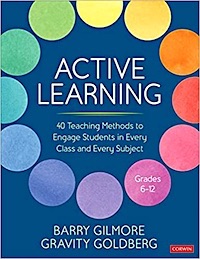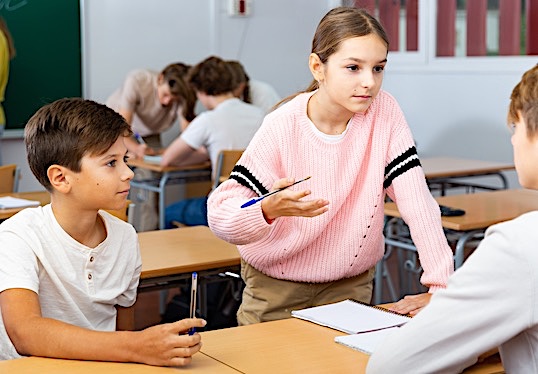Help Your Students Avoid Collaboration’s Downside
Multi-book author and teaching coach Gravity Goldberg shares ways to be sure we support student thinking and divergent ideas during their collaborative experiences.
By Gravity Goldberg

While consensus can be a useful goal in some collaborative experiences, it can also be a sign that students are playing it safe, missing nuance, or silencing divergent thinking before it is even offered.
In this post I’ll share a few downsides to seeking consensus when students are doing collaborative work and offer some other options for making collaboration more actively focused on thinking.
Some Potential Downsides to Consensus
► Partial Understandings
Few topics worth our time and attention are simple and straightforward. An essential question or inquiry experience is open-ended and not about finding a single correct answer. When students believe their job is to seek consensus, it may be a sign that they misunderstand what open-ended questions are for.
“Open-ended” signals exploration, testing out ideas, and revising thinking. Often one question leads to another and another. As understanding develops, learners begin to know what they don’t yet know. Seeking consensus can lead to partial understandings and a blindness to the parts of the topic that are not yet understood.
► Framing Difference as Negative
Author Sonya Renee-Taylor (2021) explains “rendering difference invisible validates the notion that there are parts of us that should be ignored, hidden, or minimized, leaving in place the unspoken idea that difference is the problem and not our approach to dealing with difference.”
When we send the message that agreement is the goal, we are showing students that being the same is what is valued. We don’t have the same life experiences, and that difference can be viewed as helpful and even beautiful when we let go of the need to all think in the same way.
► Lack of Connection
Socially, seeking consensus can be a way to try to feel a sense of belonging. Brene Brown (2012) taught us that “true belonging only happens when we present our authentic, imperfect selves to the world.”
This means we cannot actually feel acceptance and connection with others when we are not listening to ourselves, silencing our own thoughts and beliefs, and accepting someone else’s truths above our own. When consensus becomes the goal, we may inadvertently be missing opportunities to get to know each other better.
► Missed Perspectives
Consensus means we are leaving things out. We can agree to ignore parts of a topic, perspectives, and lingering unanswered questions. By agreeing to marginalize aspects of a topic we can get consensus, but we also get a more narrow slice of understanding.
Narrow slices can lead to echo-chambers where the ideas being discussed are no different after collaborative work than when the group began. A sign of a productive conversation might not always be agreement and instead about generating new understandings and new questions.
4 Ways We Can Support Thinking
in Collaborative Experiences
1. Take on different lenses. When students are engaged in collaborative work, you can intentionally set them up for more nuanced thinking if each person in the group takes on a different lens. For example, when discussing a topic each person could choose a different lens for analysis such as historical, environmental, economic, or social.
Since students would be entering the collaborative experience with a different focus, they are set up for thinking both within and across lenses. The goal is not to all agree on ideas but is to understand a topic in nuanced and multifaceted ways.
2. Embrace the word “and.” Two seemingly contradictory ideas can actually both be true. For example, I can be both excited to participate in an event and nervous about meeting new people. When we embrace the word “and,” it helps us collaborate by acknowledging the multiple truths that can coexist.
We have likely all taught students to use the phrases “I agree/disagree with you because…” and this sets up a dynamic that still emphasizes consensus. What if, instead of these phrases, we teach them to say “I heard you say… AND…” Students may benefit from jotting down peers’ different ideas on sticky notes and then lining them up next to each other. They can discuss how they may all be true.
Of course if a student has no evidence for their idea or if what they say is a literal misunderstanding, we don’t need to ignore that. This acknowledgment of more than one thing being true does rest on the premise that students can explain and support their thinking.
3. Generate lists of possibilities. Instead of an answer being the goal of the collaboration, set students up with the idea that generating possibility is the goal. This might look like using the words “what if…?” and giving themselves permission to imagine.
Students could come up with lists of ideas without quickly trying to narrow the list down to a single choice. For example, what if they generated a list of ways to conserve energy in a science classroom, or what if they mapped out a variety of potential claims about the character in a story. Later, on their own, students could focus on one of many possibilities but only after taking the time to generate and think through options as a group.
4. End without closure. While many of us like the period or activity to end with a sense of closure, that desire can actually impede thinking and send the message that completing activities is the goal.
What if the collaborative time ended with a “to be continued” and the group jotted down further questions and ideas to come back to? What if the debate that students were involved in ended as a cliffhanger? When we allow experiences to end without closure, we set students up to keep thinking and for groups of students to see their time together as an ongoing conversation as opposed to a checklist to complete.
One way to do this is to end the collaborative time with a few minutes of quiet writing where each student reflects on their current thinking and questions they want to revisit next time.
Keep Collaborations Open and Dynamic
While there are certainly times when agreement and consensus make sense (for example: Is this word spelled correctly? What is the capital of Wyoming?), collaborative experiences in schools are often most beneficial when they center on open-ended questions that invite students’ thinking.
Take some time to listen as your students participate in collaborative experiences and then reflect upon what supports you might put in place to help them bring in more divergent, creative, and authentic ideas. This will not only lead to more actively engaged students but also more civically prepared citizens.
References
Brown, B. (2012). Daring greatly: How the courage to be vulnerable transforms the way we live, love, parent and lead. New York, NY. Gotham Books.
Taylor, S. R. (2021). The body is not an apology (2nd ed.). Berrett-Koehler.
Learn about Gravity’s free Corwin webinar
Teaching Methods for Active Learning
Monday, May 08, 2023 – 6:30PM EDT

Gravity has over 20 years of teaching experience, including positions as a science teacher, reading specialist, third grade teacher, special educator, literacy coach, staff developer, assistant professor, educational consultant, and yoga teacher. As the founding director of Gravity Goldberg, LLC she leads a team that offers side-by-side coaching and workshops that focus on teachers as decision-makers and students as leaders of learning.


































